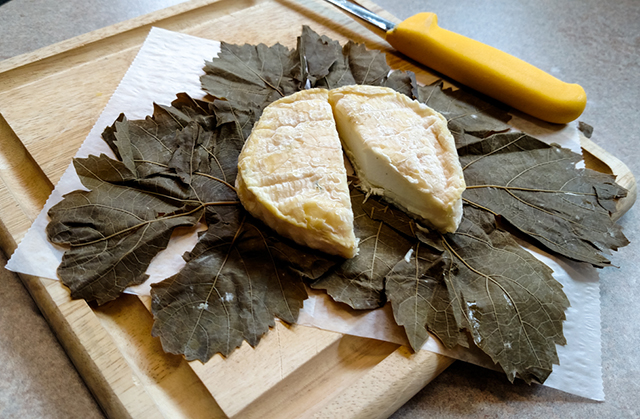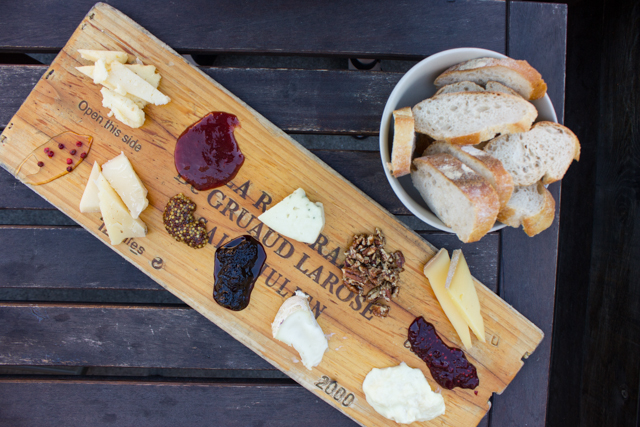Inside Chicago's Cheese World With One Of The City's Masters
By Erika Kubick in Food on Aug 14, 2015 8:35PM

The Ledyard from Meadowood Farm. Photo Credit Erika Kubick
We’ve recently been featuring some of our favorite cheese plates in the city, which left us wondering where all that glorious cheese is coming from. Is there a cheese guru guiding the city’s best chefs in their preparation? The short answer is yes: that guru is Lisa Futterman, a former chef turned cheese-slinging master who heads the wholesale program at Chicago’s epicenter of cheese, Pastoral. We grabbed a few minutes out of her busy schedule to pick her cheesy brain and discover just how she does it all.
Chicagoist: Can you tell us a little bit about your background? Where are you from?
Lisa Futterman: I grew up in Connecticut, an east-coast girl I’m proud to say. I went to college at the University of Pennsylvania, but I went to culinary school immediately afterwards and became a professional cook. I cooked in Philadelphia for eight years, then in San Francisco for eight years, and then in Chicago. In 2007, I decided to focus my career on something I could really be an expert in, and that thing was cheese.
C: Aside from the obvious reasons, why did you choose to focus on cheese?
Futterman: When I lived in California, I spent a lot of time visiting farms. I was fascinated by the artisanal cheese industry that was blossoming out there in the '90s. Beyond that, I just read a lot of books and frequented restaurants to check out their cheese plates. Then, when I moved to Chicago, I started writing a column for Time Out called “The Roquefort Files.” Of course I had interviewed people at Pastoral, so I went to the owners, Ken Miller and Greg O’Neill, and told them that I wanted to sell cheese. That was 2007. In 2008, I took over the wholesale program.
C: Who are some of your biggest clients?
Futterman: The biggest in volume is definitely Three Floyds Brew Pub, in Munster, Indiana. They are incredibly enthusiastic and interested in everything about cheese: making it, learning about where it’s from, aging it. We’ve actually sent their beer to Capriole, a goat farm in Indiana, who uses that beer to wash their Mt. St. Francis cheese. Once that cheese is ready, we sell it back to them and they have their own custom, beer-washed cheese. Our friends at Found are also great customers; chef Nicole Peterson happens to be one of my best personal friends. We worked together at Pastoral, and that’s how I met her. The One Off Hospitality [Editor's note: includes Blackbird, Avec, among others] restaurants are also very important to my work portfolio, among others.
C: Where are some of your personal favorite cheese plates in this city?
Futterman: Another one of my very big customers is Rootstock. Chef Michael Simmons will send me a text that’s only a number, and that translates to “send me that many cheeses this week.” Occasionally he’ll throw in a preference, but he trusts me to send him a really nice selection. That’s a great place to eat cheese because it changes every week, it’s well-presented, and it’s special stuff.
C: How do you go about curating cheeses for restaurants?
Futterman: The first question I ask them is if they’re interested in local, Midwest, domestic or imported cheeses. Then I ask them how they are going to serve it: if they’re going to have a traditional cheeseboard, how many cheeses they’re looking for, whether they are planning to offer them individually or as a group. Then we taste.
I love going to restaurants and bringing samples, but when they come to the warehouse, I have over 200 cheeses at any given time. What I like to tell people is that I will curate for them and send them a beautiful cheese selection every week. But a lot of chefs, of course, want to be more involved. Another variable is how long the cheese stays on the menu. If they’re constantly changing the menu, like at Rootstock, they’ll get those unique, special cheeses that we have in such a limited supply.

The cheese plate at Rootstock, featuring The Ledyard and house made accoutrements.
C: What cheese are you most excited about right now?
Futterman: We have a new cheese that I actually haven’t tasted yet, so let’s taste it together. This is Ledyard, from Meadowood Farms, in New York. It’s a soft-ripened sheep’s milk cheese made in the style of Robiola and wrapped in grape leaves. It’s such a heady little cheese that it makes you dizzy. It tastes so much like a Robiola, but with a more dense texture. It has that beautiful cream cheese flavor with a gorgeous Geotrichum rind. I don’t taste much influence from the leaf but I like that it keeps it moist.
Of course, this time of year I’m also interested in Prairie Fruits Farms. They have truly seasonal cheeses that we only get from April to December. I think they’re amazing, so I’m taking some Little Blooms and Black Goats to Boka today.
C: You really seem to identify with your product. If you were a cheese, which one would you be?
Futterman: Oh, that’s a tough one. I know I’m a tough cheese, but I’m so tender and giving on the inside. Maybe I’d be like a Pecorino Camomilla, an Italian sheep’s milk with chamomile leaves on the outside. It’s a little off-putting, and kind of herbal, and rough on the outside, but then you cut into it and it has a very tender taste. It’s not delicate at all, just not as sharp as you’d expect it to be from the outside.
C: If you had to marry a cheese, which would you marry?
Futterman: I don’t think I know a cheese that could care for me the way I care for cheese, so that’s tough. But if I were to choose, I’d marry Fulvi Pecorino Romano. First of all, we’re a lot alike because we’re both Pecorinos. He’s big, he’s kind of salty and oily, but he’s not super sophisticated. He’s very approachable, but he also has a lot of personality. I’m going to marry a Mr. Pecorino Romano.